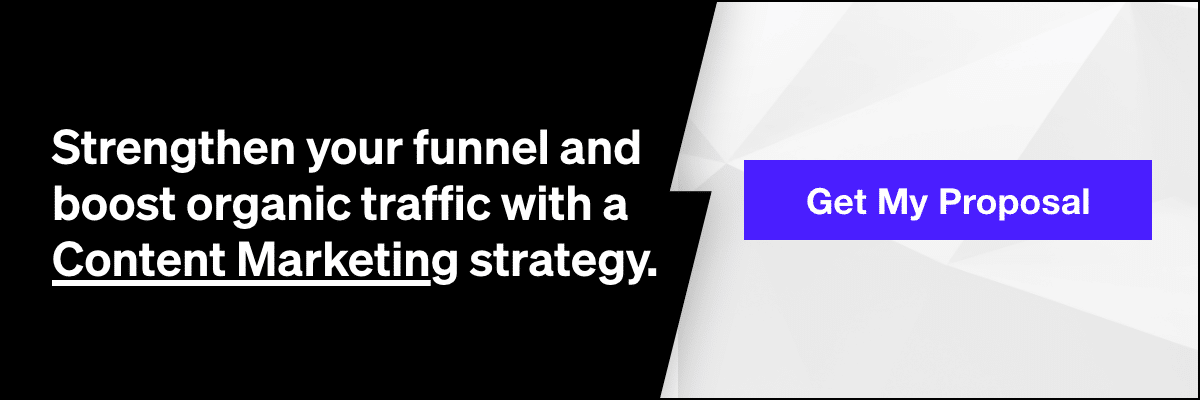How to Measure Content Marketing ROI

Intro: What is Content Marketing ROI?
In content marketing, return on investment (ROI) is how much you spend on content marketing in relation to the revenue you earn from your digital marketing agency efforts. ROI isn’t immediate with content marketing, as it can take several months for your content strategy to have apparent results. Although it might not be quick, it can still have an enormous impact on a brand’s performance.
Let’s dive into how to measure and increase ROI when developing your content marketing plan.
How to Measure ROI
To understand the success of your content strategy, it’s essential to establish which content marketing metrics, or key performance indicators (KPI’s), you should be tracking as a content marketer. For example:
- Are you mainly interested in generating brand awareness? If so, website traffic might be what you choose to pay attention to.
- Are you looking to rank number one on Google’s search engine results pages (SERP) with your blog post? If that’s the case, keeping track of your keyword movement should likely be top of mind.
- Are you looking to see assisted conversions from your marketing efforts? Keeping an eye on your content’s conversion rate could make the most sense.
No matter the content marketing success metrics you choose to adopt, your business’s content strategy should be customized to fit your larger business goals.
It’s also vital to note that engagement and ROI are not separate metrics, but have a significant influence on each other. We recommend creating a robust process to determine all opportunities to test your content piece length, calls to action (CTAs) within the blog post, total time spent on the page, and see if any of those impact your organic traffic, assisted conversions, or keyword rankings. By examining how such changes affect your analytics, you can start to gain a better idea of your overall content ROI.
One key thing to remember when measuring the ROI of your content creation is that your success is relative. Like any other marketing channel, the competitive landscape is constantly changing and it’s important to always evaluate your content performance and identify areas where you can experiment to see improvements.
How to Improve ROI
There are a few ways you can improve your content marketing ROI: use content to support your core converting pages, create more quality content that converts, and make sure your other channels are maximizing the value of your blog’s qualified traffic.
Use Your Content Strategy to Support SEO
You first need to evaluate how your current content strategy is supporting your overall organic growth goals. Consider your core revenue-driving or converting pages and how you can utilize your content marketing strategy to bolster those.
For example, if one of your top-converting pages is ranking at the bottom of page one or on page two for a relevant keyword, you may want to utilize your content marketing strategy to build authority around that page and link back to it. By using your content strategy to improve visibility and increase traffic to your core revenue-driving or converting pages, you’ll be able to see a larger return on investment for your content marketing campaign.
Create More Content That Converts
If you’re looking to improve your content marketing ROI with a direct impact from the blog, you might want to take a look at your top-revenue driving or top-converting blog posts. These may uncover findings that could translate into similar topics that could convert. Maybe your top-performing topics fill a middle-of-funnel content need for your audience and this is leading to increased conversions. In which case, add more middle-of-the-funnel content into your strategies to boost your content marketing ROI.
Learn more: A Guide to Marketing Funnels
Make Sure Your Other Channels Are Set Up For Success
A core benefit of any content marketing strategy is the qualified traffic it brings to your website. By filling the top of the funnel with people who are looking for information related to your products or services, you have a much larger remarketing pool of potential customers/leads. In order to improve your content marketing ROI, you want to make sure your other digital marketing channels are set up for success to maximize touchpoints.
For example, a person may land on your blog organically through a search query. If your paid media social strategy isn’t buttoned up and remarketing to that same person through an ad on Instagram, you’ll miss out on moving them through the funnel. Content marketing can play a huge role in assisted conversions, but not if your other channels aren’t successful.
Setting Benchmarks
To set your content strategy up for success, you have to set clear goals. Let’s start by identifying several metrics you can use as benchmarks:
- Website traffic by source/medium
- User behavior, such as time on page or bounce rate
- Impressions and click-through rate (CTR)
- Lead generation
- Keyword rankings
By creating benchmarks, you allow yourself to see how your strategy is performing at any given point and how your performance metrics change over time. When analyzing your data, you should always be keeping a close eye on your competitors. Shift your focus from industry-wide benchmarks to benchmarks against your top rivals. Make sure you understand the share of social proof or search results they have so you can properly forecast your trajectory.
For instance, if you’re looking at a number of leads, anyone can do that, so dig deeper to better understand the customer journey and strategies that have impacted growth. Ask yourself and your team questions such as:
- What percentage of your organic search leads become purchasers?
- How many “high-quality” leads result in a sale?
Can Your Content Marketing Strategy Make You Money?
Short answer? Yes! That said, it’s not always immediate and it’s not always direct.
You will need at least 3 months worth of crawls by Google to start to see the leading indicators of a new SEO-based content strategy and at least 6 months before you are really humming. And when it comes to direct content revenue, we like to view that as a cherry on top.
For example, if you run an SEO-based content marketing strategy for a successful ecommerce business, you’ll likely see some direct conversions come through the blog. However, most people aren’t going to conduct a top of funnel Google search to find an answer and immediately convert right then and there. This is why your content should aim to support the growth of core pillar/transactional pages of the site through a technical internal linking strategy and continuously introduce monthly new users to the brand so you can retarget them through paid advertising and push them farther down the funnel.
When looking to demonstrate positive ROI through your content marketing efforts, it’s important to consider additional success metrics such as assisted revenue and overall growth in organic revenue. In highlighting details like a customer’s last touchpoint before a purchase, these metrics can help to showcase the success of an integrated content marketing, on-page, and off-page SEO strategy.
Make Your Content Count
Your content marketing strategy can have an enormous impact on your business over time. It’s a marketing strategy that can be very effective for top-of-funnel traffic, which means a greater quantity of fresh eyes on your business. However, the most important thing to remember is that measuring content marketing ROI is really dependent on what success means to you and your business. Remember to set benchmarks so that you know what performance looks like, then don’t be afraid to adjust your goals over time and pivot your content marketing strategies for the optimal performance you’re looking for.
Whether you have an ecommerce, business to business (B2B), or lead generation business, content marketing can move the needle and help you acquire customers in a more cost effective way.
Our Editorial Standards
Reviewed for Accuracy
Every piece is fact-checked for precision.
Up-to-Date Research
We reflect the latest trends and insights.
Credible References
Backed by trusted industry sources.
Actionable & Insight-Driven
Strategic takeaways for real results.










